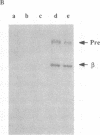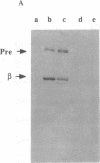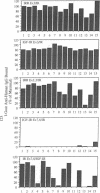Abstract
Chimeric receptors containing different portions of the homologous human insulin receptor, insulin-like growth factor I receptor, and insulin receptor-related receptor were utilized to identify the epitopes recognized by various anti-insulin receptor antibodies. The antibodies studied included 12 monoclonal antibodies to the extracellular domain of the human insulin receptor as well as 15 patients' sera with autoimmune anti-insulin receptor antibodies. All of the patients' sera and all 8 monoclonal antibodies that inhibit insulin binding were found to recognize an epitope contained within residues 450-601 of the alpha subunit of the receptor. In contrast, 2 monoclonal antibodies that do not inhibit insulin binding were found to recognize the cysteine-rich region of the alpha subunit. Chimeric insulin receptors that had residues 450-601 replaced with the homologous residues of the insulin-like growth factor I receptor exhibited a decreased ability to bind insulin. In contrast, insulin-like growth factor I receptors that have had the comparable region replaced with that of the insulin receptor showed no decrease in their ability to bind ligand. These results indicate that residues 450-601 of the insulin receptor are important for insulin binding and include the major site for recognition by inhibitory monoclonal antibodies and patients' autoimmune anti-receptor antibodies.
Full text
PDF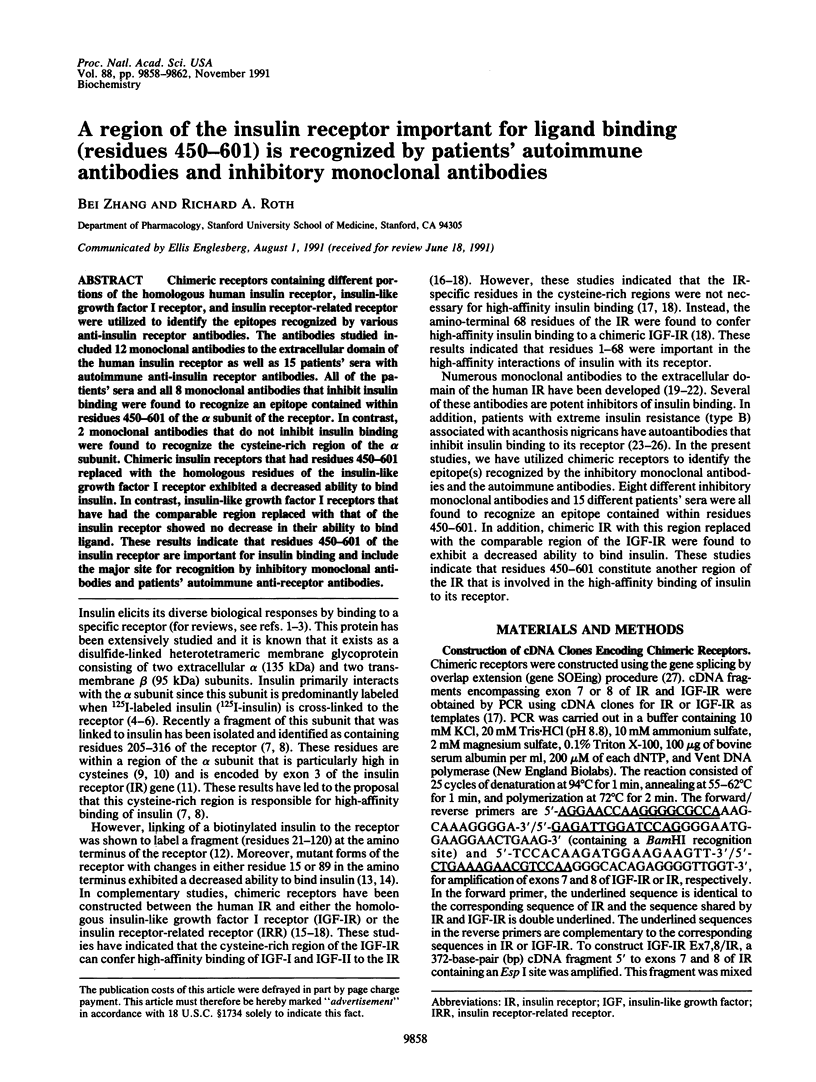
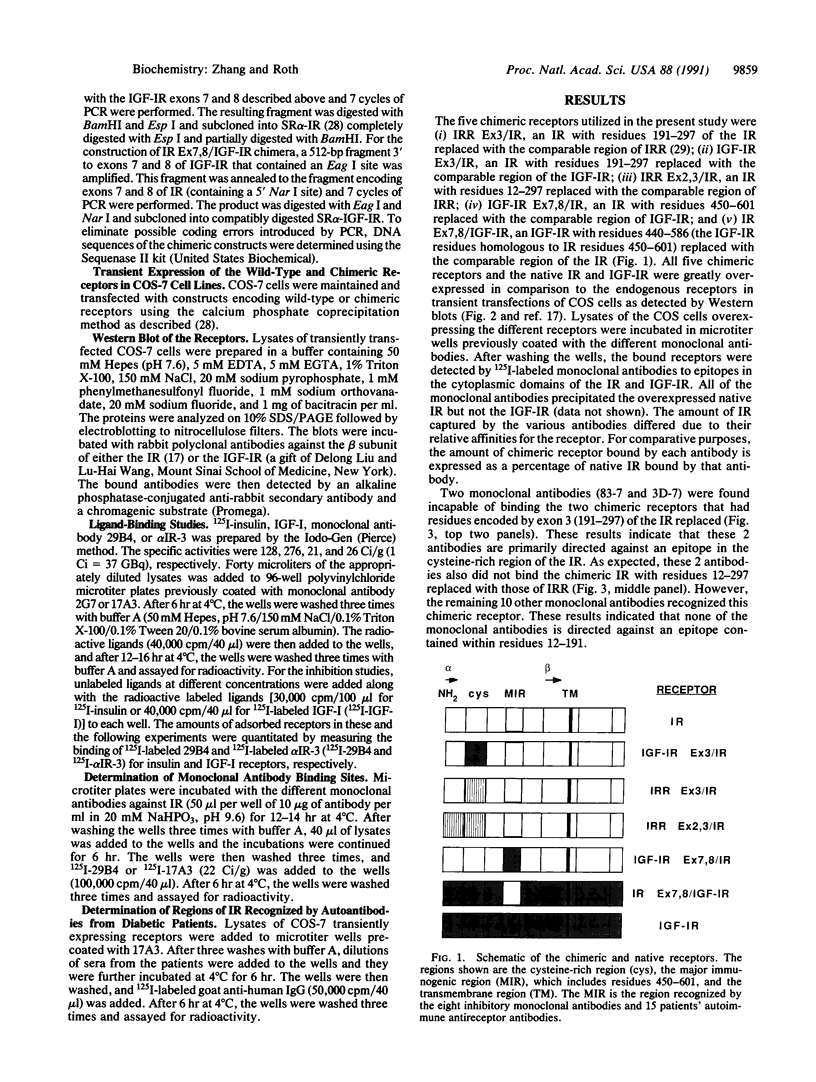
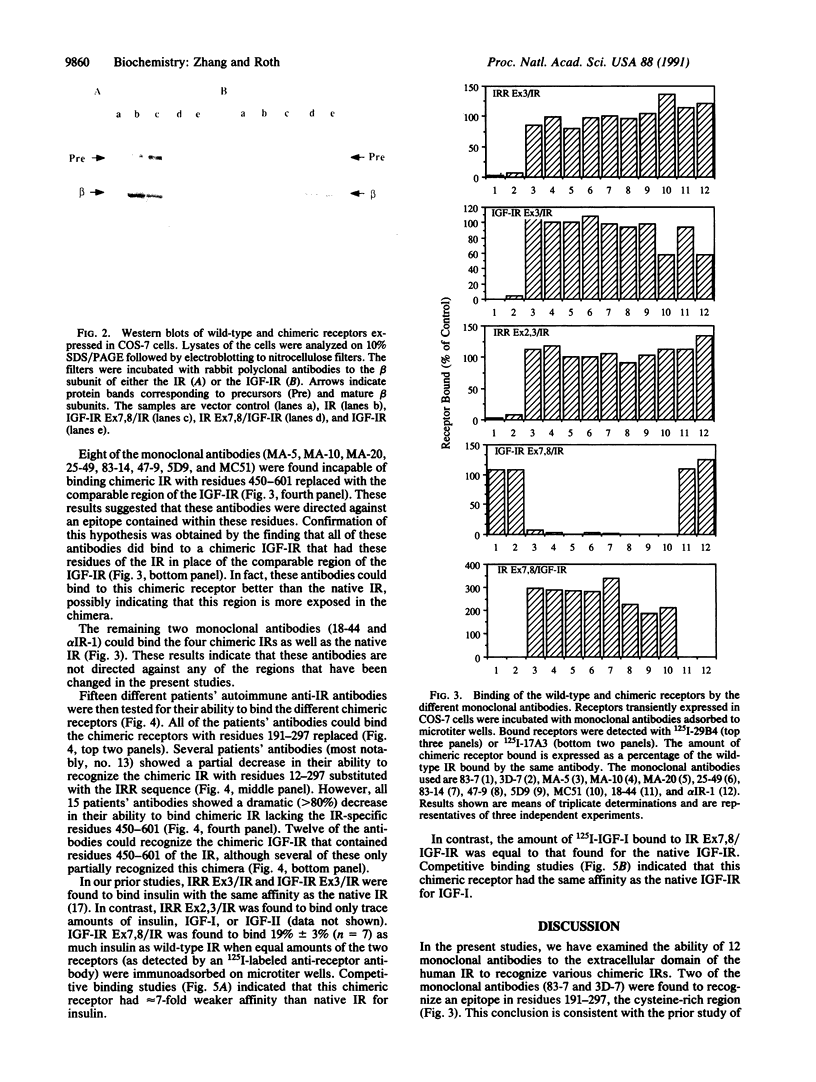
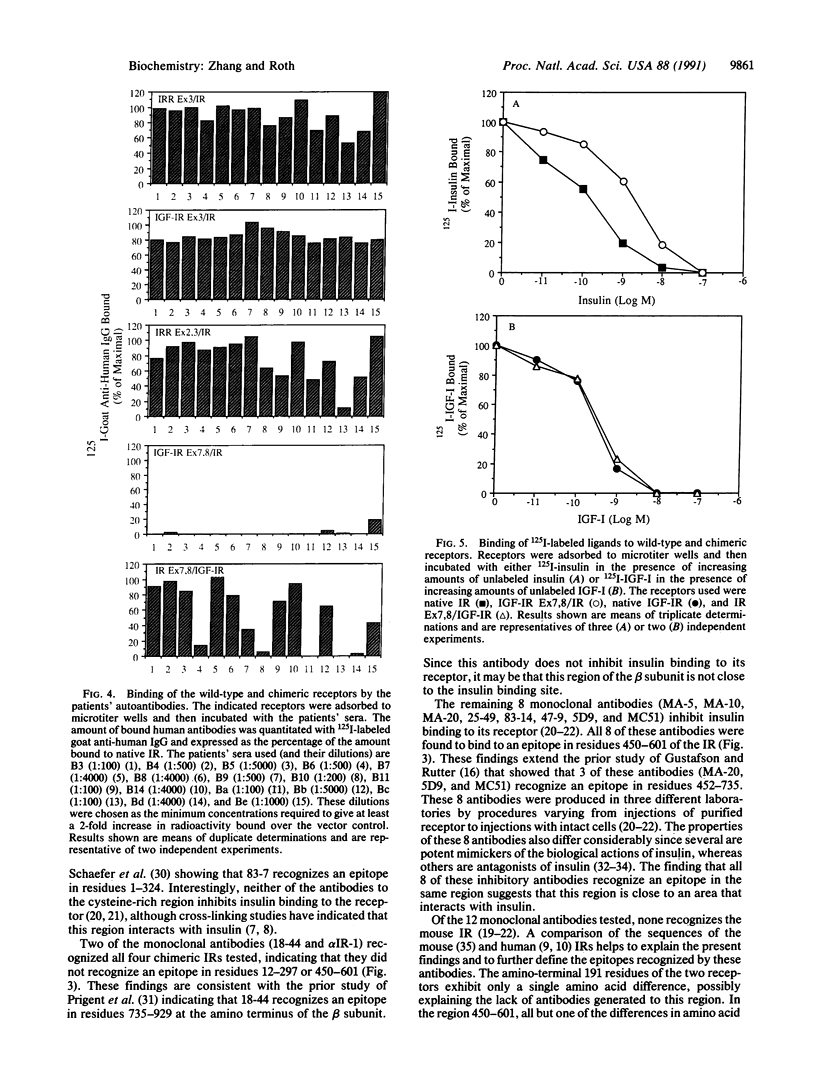
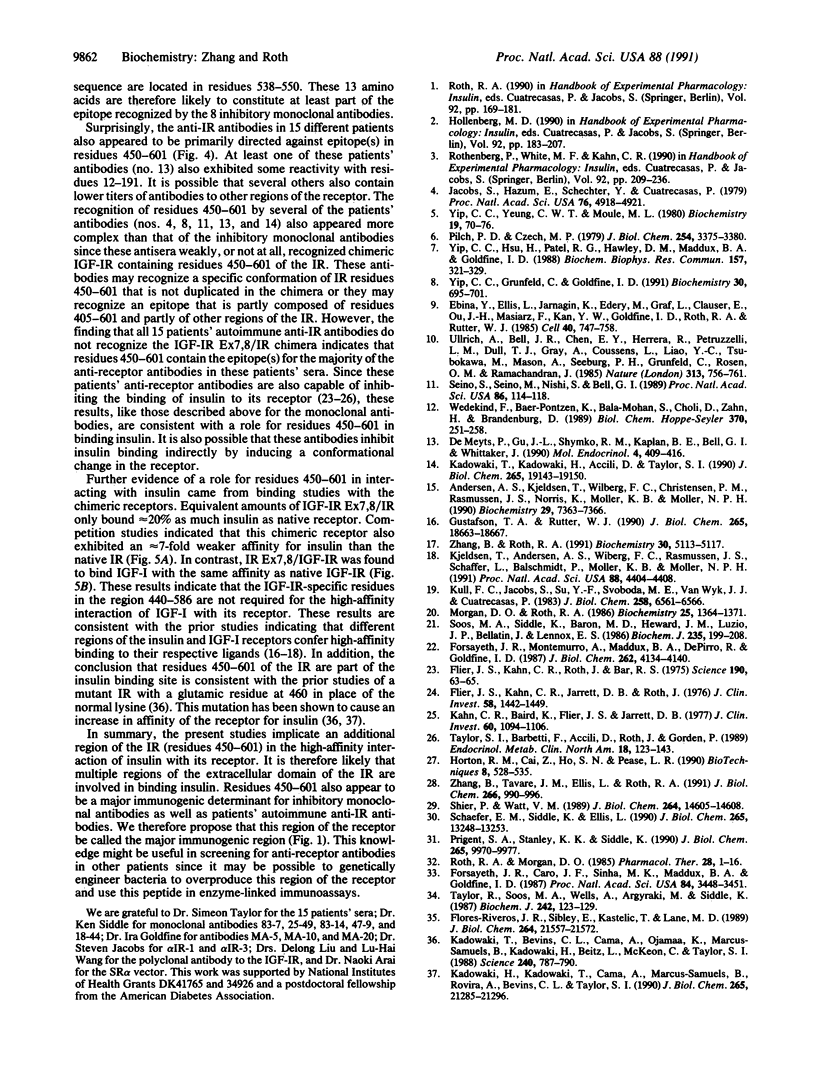
Images in this article
Selected References
These references are in PubMed. This may not be the complete list of references from this article.
- Andersen A. S., Kjeldsen T., Wiberg F. C., Christensen P. M., Rasmussen J. S., Norris K., Møller K. B., Møller N. P. Changing the insulin receptor to possess insulin-like growth factor I ligand specificity. Biochemistry. 1990 Aug 14;29(32):7363–7366. doi: 10.1021/bi00484a002. [DOI] [PubMed] [Google Scholar]
- De Meyts P., Gu J. L., Shymko R. M., Kaplan B. E., Bell G. I., Whittaker J. Identification of a ligand-binding region of the human insulin receptor encoded by the second exon of the gene. Mol Endocrinol. 1990 Mar;4(3):409–416. doi: 10.1210/mend-4-3-409. [DOI] [PubMed] [Google Scholar]
- Ebina Y., Ellis L., Jarnagin K., Edery M., Graf L., Clauser E., Ou J. H., Masiarz F., Kan Y. W., Goldfine I. D. The human insulin receptor cDNA: the structural basis for hormone-activated transmembrane signalling. Cell. 1985 Apr;40(4):747–758. doi: 10.1016/0092-8674(85)90334-4. [DOI] [PubMed] [Google Scholar]
- Flier J. S., Kahn C. R., Jarrett D. B., Roth J. Characterization of antibodies to the insulin receptor: a cause of insulin-resistant diabetes in man. J Clin Invest. 1976 Dec;58(6):1442–1449. doi: 10.1172/JCI108600. [DOI] [PMC free article] [PubMed] [Google Scholar]
- Flier J. S., Kahn C. R., Roth J., Bar R. S. Antibodies that impair insulin receptor binding in an unusual diabetic syndrome with severe insulin resistance. Science. 1975 Oct 3;190(4209):63–65. doi: 10.1126/science.170678. [DOI] [PubMed] [Google Scholar]
- Flores-Riveros J. R., Sibley E., Kastelic T., Lane M. D. Substrate phosphorylation catalyzed by the insulin receptor tyrosine kinase. Kinetic correlation to autophosphorylation of specific sites in the beta subunit. J Biol Chem. 1989 Dec 25;264(36):21557–21572. [PubMed] [Google Scholar]
- Forsayeth J. R., Caro J. F., Sinha M. K., Maddux B. A., Goldfine I. D. Monoclonal antibodies to the human insulin receptor that activate glucose transport but not insulin receptor kinase activity. Proc Natl Acad Sci U S A. 1987 May;84(10):3448–3451. doi: 10.1073/pnas.84.10.3448. [DOI] [PMC free article] [PubMed] [Google Scholar]
- Forsayeth J. R., Montemurro A., Maddux B. A., DePirro R., Goldfine I. D. Effect of monoclonal antibodies on human insulin receptor autophosphorylation, negative cooperativity, and down-regulation. J Biol Chem. 1987 Mar 25;262(9):4134–4140. [PubMed] [Google Scholar]
- Gustafson T. A., Rutter W. J. The cysteine-rich domains of the insulin and insulin-like growth factor I receptors are primary determinants of hormone binding specificity. Evidence from receptor chimeras. J Biol Chem. 1990 Oct 25;265(30):18663–18667. [PubMed] [Google Scholar]
- Horton R. M., Cai Z. L., Ho S. N., Pease L. R. Gene splicing by overlap extension: tailor-made genes using the polymerase chain reaction. Biotechniques. 1990 May;8(5):528–535. [PubMed] [Google Scholar]
- Jacobs S., Hazum E., Shechter Y., Cuatrecasas P. Insulin receptor: covalent labeling and identification of subunits. Proc Natl Acad Sci U S A. 1979 Oct;76(10):4918–4921. doi: 10.1073/pnas.76.10.4918. [DOI] [PMC free article] [PubMed] [Google Scholar]
- Kadowaki H., Kadowaki T., Cama A., Marcus-Samuels B., Rovira A., Bevins C. L., Taylor S. I. Mutagenesis of lysine 460 in the human insulin receptor. Effects upon receptor recycling and cooperative interactions among binding sites. J Biol Chem. 1990 Dec 5;265(34):21285–21296. [PubMed] [Google Scholar]
- Kadowaki T., Bevins C. L., Cama A., Ojamaa K., Marcus-Samuels B., Kadowaki H., Beitz L., McKeon C., Taylor S. I. Two mutant alleles of the insulin receptor gene in a patient with extreme insulin resistance. Science. 1988 May 6;240(4853):787–790. doi: 10.1126/science.2834824. [DOI] [PubMed] [Google Scholar]
- Kadowaki T., Kadowaki H., Accili D., Taylor S. I. Substitution of lysine for asparagine at position 15 in the alpha-subunit of the human insulin receptor. A mutation that impairs transport of receptors to the cell surface and decreases the affinity of insulin binding. J Biol Chem. 1990 Nov 5;265(31):19143–19150. [PubMed] [Google Scholar]
- Kahn C. R., Baird K., Filier J. S., Jarrett D. B. Effects of autoantibodies to the insulin receptor on isolated adipocytes. Studies of insulin binding and insulin action. J Clin Invest. 1977 Nov;60(5):1094–1106. doi: 10.1172/JCI108861. [DOI] [PMC free article] [PubMed] [Google Scholar]
- Kjeldsen T., Andersen A. S., Wiberg F. C., Rasmussen J. S., Schäffer L., Balschmidt P., Møller K. B., Møller N. P. The ligand specificities of the insulin receptor and the insulin-like growth factor I receptor reside in different regions of a common binding site. Proc Natl Acad Sci U S A. 1991 May 15;88(10):4404–4408. doi: 10.1073/pnas.88.10.4404. [DOI] [PMC free article] [PubMed] [Google Scholar]
- Kull F. C., Jr, Jacobs S., Su Y. F., Svoboda M. E., Van Wyk J. J., Cuatrecasas P. Monoclonal antibodies to receptors for insulin and somatomedin-C. J Biol Chem. 1983 May 25;258(10):6561–6566. [PubMed] [Google Scholar]
- Morgan D. O., Roth R. A. Mapping surface structures of the human insulin receptor with monoclonal antibodies: localization of main immunogenic regions to the receptor kinase domain. Biochemistry. 1986 Mar 25;25(6):1364–1371. doi: 10.1021/bi00354a026. [DOI] [PubMed] [Google Scholar]
- Pilch P. F., Czech M. P. Interaction of cross-linking agents with the insulin effector system of isolated fat cells. Covalent linkage of 125I-insulin to a plasma membrane receptor protein of 140,000 daltons. J Biol Chem. 1979 May 10;254(9):3375–3381. [PubMed] [Google Scholar]
- Prigent S. A., Stanley K. K., Siddle K. Identification of epitopes on the human insulin receptor reacting with rabbit polyclonal antisera and mouse monoclonal antibodies. J Biol Chem. 1990 Jun 15;265(17):9970–9977. [PubMed] [Google Scholar]
- Roth R. A., Morgan D. O. Monoclonal antibodies to the insulin receptor. Pharmacol Ther. 1985;28(1):1–16. doi: 10.1016/0163-7258(85)90079-8. [DOI] [PubMed] [Google Scholar]
- Schaefer E. M., Siddle K., Ellis L. Deletion analysis of the human insulin receptor ectodomain reveals independently folded soluble subdomains and insulin binding by a monomeric alpha-subunit. J Biol Chem. 1990 Aug 5;265(22):13248–13253. [PubMed] [Google Scholar]
- Seino S., Seino M., Nishi S., Bell G. I. Structure of the human insulin receptor gene and characterization of its promoter. Proc Natl Acad Sci U S A. 1989 Jan;86(1):114–118. doi: 10.1073/pnas.86.1.114. [DOI] [PMC free article] [PubMed] [Google Scholar]
- Shier P., Watt V. M. Primary structure of a putative receptor for a ligand of the insulin family. J Biol Chem. 1989 Sep 5;264(25):14605–14608. [PubMed] [Google Scholar]
- Soos M. A., Siddle K., Baron M. D., Heward J. M., Luzio J. P., Bellatin J., Lennox E. S. Monoclonal antibodies reacting with multiple epitopes on the human insulin receptor. Biochem J. 1986 Apr 1;235(1):199–208. doi: 10.1042/bj2350199. [DOI] [PMC free article] [PubMed] [Google Scholar]
- Taylor R., Soos M. A., Wells A., Argyraki M., Siddle K. Insulin-like and insulin-inhibitory effects of monoclonal antibodies for different epitopes on the human insulin receptor. Biochem J. 1987 Feb 15;242(1):123–129. doi: 10.1042/bj2420123. [DOI] [PMC free article] [PubMed] [Google Scholar]
- Taylor S. I., Barbetti F., Accili D., Roth J., Gorden P. Syndromes of autoimmunity and hypoglycemia. Autoantibodies directed against insulin and its receptor. Endocrinol Metab Clin North Am. 1989 Mar;18(1):123–143. [PubMed] [Google Scholar]
- Ullrich A., Bell J. R., Chen E. Y., Herrera R., Petruzzelli L. M., Dull T. J., Gray A., Coussens L., Liao Y. C., Tsubokawa M. Human insulin receptor and its relationship to the tyrosine kinase family of oncogenes. 1985 Feb 28-Mar 6Nature. 313(6005):756–761. doi: 10.1038/313756a0. [DOI] [PubMed] [Google Scholar]
- Wedekind F., Baer-Pontzen K., Bala-Mohan S., Choli D., Zahn H., Brandenburg D. Hormone binding site of the insulin receptor: analysis using photoaffinity-mediated avidin complexing. Biol Chem Hoppe Seyler. 1989 Mar;370(3):251–258. doi: 10.1515/bchm3.1989.370.1.251. [DOI] [PubMed] [Google Scholar]
- Yip C. C., Grunfeld C., Goldfine I. D. Identification and characterization of the ligand-binding domain of insulin receptor by use of an anti-peptide antiserum against amino acid sequence 241-251 of the alpha subunit. Biochemistry. 1991 Jan 22;30(3):695–701. doi: 10.1021/bi00217a016. [DOI] [PubMed] [Google Scholar]
- Yip C. C., Hsu H., Patel R. G., Hawley D. M., Maddux B. A., Goldfine I. D. Localization of the insulin-binding site to the cysteine-rich region of the insulin receptor alpha-subunit. Biochem Biophys Res Commun. 1988 Nov 30;157(1):321–329. doi: 10.1016/s0006-291x(88)80050-0. [DOI] [PubMed] [Google Scholar]
- Yip C. C., Yeung C. W., Moule M. L. Photoaffinity labeling of insulin receptor proteins of liver plasma membrane preparations. Biochemistry. 1980 Jan 8;19(1):70–76. doi: 10.1021/bi00542a011. [DOI] [PubMed] [Google Scholar]
- Zhang B., Roth R. A. Binding properties of chimeric insulin receptors containing the cysteine-rich domain of either the insulin-like growth factor I receptor or the insulin receptor related receptor. Biochemistry. 1991 May 28;30(21):5113–5117. doi: 10.1021/bi00235a001. [DOI] [PubMed] [Google Scholar]
- Zhang B., Tavaré J. M., Ellis L., Roth R. A. The regulatory role of known tyrosine autophosphorylation sites of the insulin receptor kinase domain. An assessment by replacement with neutral and negatively charged amino acids. J Biol Chem. 1991 Jan 15;266(2):990–996. [PubMed] [Google Scholar]




